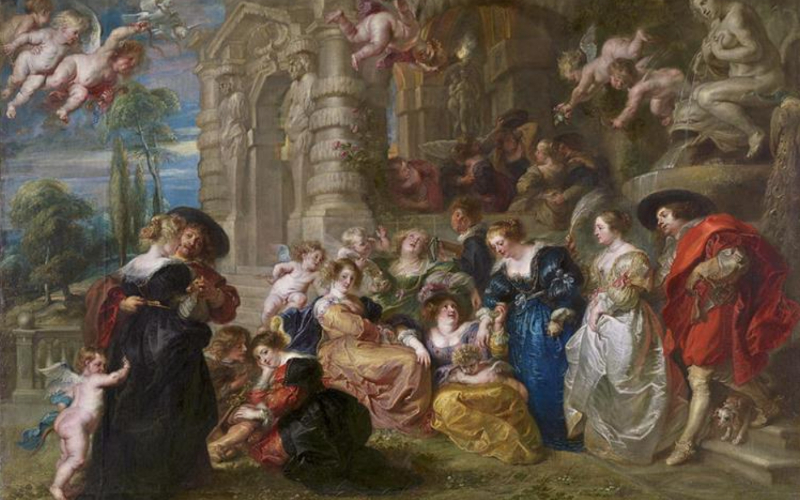A painting by Rubens called The Garden of Love, created somewhere around 1633, is currently on display in the Prado Museum in Madrid.
The piece was first recorded in 1666, when the Spanish king had it hanging in his chamber at the Royal Palace of Madrid. The artwork was known as The Garden Party in the earliest inventory.
It is the pinnacle of the outdoor courtly Merry Company genre. The topic of this picture is typical of Baroque art, which emphasized drama, tension, and grandeur through exaggerated motion and easily understood detail. In his paintings, Rubens employs multi-layered allegory and symbolism.
Artwork Description
A huge group of elegant people dressed in the manner of the 17th century lay around, enjoying a picnic in a picturesque garden in this 6.5 ft × 9.4 ft piece. Everyone is dressed elegantly, flaunting their money and upper class status. This gives a recessional example of the depth of a full court scene. In order to create a fantasy artwork, Cupids mingle with the people and insert mythological creatures into a realistic garden scene.
Symbols of marital love may be seen all throughout the group, including the cupids, a pair of doves, flower crowns, music, and Juno’s peacock. The dogs stand for fidelity and loyalty. The garden symbolizes both fertility and paradise. This picture is an allegory that exalts love, marriage, and good times with friends.
A woman dressed entirely in black is being escorted toward the group by a masculine gentleman in the far left corner. Given that the figure is thought to be Rubens, this picture was once thought to be a self-portrait with friends. The Garden of Love is thought to have been a celebration of his union with Hélène Fourment, the wife of Rubens.
Rubens’ second wife was Helena Fourment. She served as the model for a number of religious and mythical paintings by Rubens, as well as a handful of his portraits.
The Three Graces and Venus fountains stand in for a happy marriage. The Three Graces fountains are three soft-bodied, sensuous, and very sexualized Rubenesque females in nudity.
These shapes mimic the lovely garden setting by emphasizing fecundity and physical attractiveness. A group of people who are not paying attention getting splashed by the fountain directly beneath the Graces.
The second fountain similarly features a naked woman, but this time Venus is seen seated on a fish and shooting water out of her breasts. This is referred to as the Nursing Venus and is believed to represent giving birth to and raising children.
The peacock recognizes this slender woman as the goddess Juno, the patron goddess of union. Rubens uses topics that his audience of the time would be familiar with.
The tableau is set in the mannerist portico of Rubens’ own house in Antwerp, although he draws inspiration from Renaissance artworks.
Adriaen Brouwer, a Baroque Flemish painter of profoundly lifelike joyful company genre pieces, had an impact on Rubens’ merry company.
Although about 60 of his works are known, the subsequent generation of Flemish and Dutch genre painters was influenced by Brouwer. Rubens’ work clearly displays the influence of Brouwer’s ethereal landscapes and free-flowing brushstrokes.


